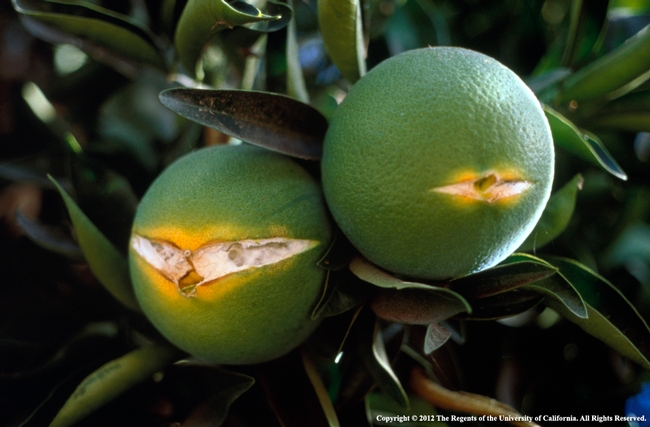Orange Splitting
By Polly Nelson UCCE Master Gardener
Some of the fruit on my navel orange tree splits before it ripens. What's happening? Nell P., SLO
The problem is likely caused by the internal pressure inside the orange increasing more than the rind can handle, so the fruit splits like an over-inflated tire. It usually occurs in green fruit between September and November. Drought-stressed navel oranges are affected; other orange varieties not so much. This may be because the split usually starts at the navel end, the thinnest part of the rind. The split can be short and shallow, or deep and wide. Fortunately, it is not caused by pests or diseases. Fruit split is likely the result of stress to the tree. One or more environmental and cultural conditions contribute to the problem, including extreme temperature changes, wind, humidity, insufficient soil moisture, and potassium deficiencies. Hot weather, especially with winds, causes the tree to take water from young fruit, softening it. If the tree is then irrigated heavily, the dehydrated fruit swells, causing the rind to split. Most susceptible are young or dwarf varieties with small, shallow root systems, or trees grown in sandy soils that don't retain sufficient moisture.
Factors you can control include irrigation and fertilizer applications. Consider the age of the tree and the weather when deciding how much and how often to water. Younger trees need to be irrigated more frequently because their developing root systems dry out more quickly than older trees. Check the moisture of the soil below one inch to decide if the tree needs water. Follow the weather forecast and prepare to irrigate before hot windy days, then irrigate lightly for a few days if needed. Apply irrigation to a large area of soil around the tree while keeping the base of the tree trunk dry. If trees are fertilized, water first, apply according to the label instructions and water afterwards. Do not over-fertilize. Consider smaller monthly applications of quick-release fertilizer from February through May instead of a single large application. Time-release fertilizers conveniently supply nutrients at an even rate throughout the growing season.
Remove and discard damaged fruit to prevent unwanted insects and the spread of bacteria, and fungi.
For more information go to: http://ucanr.edu/repository/a/?get=54110
